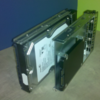
Once upon a time, data storage performance (or I/O performance) was measured in "spindles": The disk drive count in the array. For those not intimately familiar with RAID (Redundant Array of Inexpensive Disks), this is the most common means of assembling multiple disk drives into one "logical" disk drive, so that data, such as a sizable file, may be stored in bits and pieces across them. No single disk drive contains all of the file. All the disk drives must be used together in tandem to access the full file, which is the whole point.
There are two reasons why RAID is used: Redundancy (or data integrity/safety) and performance. As the latter is sought after, the former becomes increasingly important.
In most cases where RAID is used, it is performance that is actively sought after. Even with the ever increasing spindle speeds (i.e.: 7.5k, to 10k, and now even 15k RPM speeds being common), this RPM is the Achilles Heel of disk drive performance. Disk drives simply spend too much time -- basically their entire latency period -- waiting for the read/write needle (called a head) to physically move to the track being sought after on the disk drive, and there again waiting for the disk to physically rotate to the point where the specific part of the track (called a sector) is directly underneath the head.
You can only move a head so fast before the materials either warp or break apart, and you can only spin a disk so fast before the platter literally disintegrates and breaks apart. The industry is very limited by the physics at play on the materials being used.
In the midst of this dilemma, enters a hard drive without the physics. Or at least without the physics of inertia and momentum. Here enters the SSD: Solid State Disk (or Drive).
Our hardware vendor brought these to our attention with our latest inquiry on pricing and availability of disk drives. We were seeking those with the highest performance, but with the smallest capacity. This is not an unusual request for us since our services are always pushing the performance envelope over the capacity envelope. Unlike previous inquiries, however, our vendor came back with a suggestion that we try out the new SSD offering.
Now, SSD is nothing new. To a limited degree, SSD is no different than a micro SD card or compact flash card used in phones and cameras. For decades there have even been devices which permit the usage of RAM via a disk drive interface, some containing a battery back-up to retain data between power cycles.
However, the modern day SSD is an amalgamation of both. Not nearly as speedy as outright RAM (SIMM, DIMM, SDRAM, DDR, or otherwise), but much more stable and non-volatile -- not requiring battery back-up.
The problem with the RAM drives of yester-year (data integrity issues aside) was cost. One could purchase several piles of disk drives for the price in RAM of one modest sized disk drive. Disk drive costs have largely remained the same over the years. Naturally, capacities ever increase -- we started with 9GB drives whereas now the minimum available size is 73GB -- but the cost for each drive remains the same. We don't need the capacity, we need the spindles and thereby the performance, so our costs have largely remained the same. We gained a lot by the increased spindle speeds, but not enough. We have often employed dozens of disk drives to keep performance adequate for our more active sites, with unused free space reaching ludicrous proportions. Meanwhile RAM (and related solid state technologies like usb thumb drives, SD cards, CF cards, etc.) have had explosive growth in capacity combined with plummeting costs to purchase. Win-win.
So here we are now where it just so happens that SSDs are now fiscally viable for those seeking maximum performance with modest capacity. A single pair of these drives should out-perform a fully loaded typical drive array (8-14 disks) in write throughput, with several times that in read performance. And all for a cost less than that of a fully loaded array.
So, I sit here gazing at this 2.5" marvel realizing that unless I am way off my mark, this represents the most significant revolution in server technology in my more than 10 years in the field. I think of the full racks of disk drive enclosures which could be replaced with a mere handfull of these SSDs -- never mind that double the number of these 2.5" form factor SSDs can fit in the same space as our standard 3.5" form factor disk drives. It is only a matter of time before the whine of the disk drive is no more. Some day, perhaps only a few years even, data centers are going to become much more silent, because servers are going to have screaming fast I/O, without the scream.
Regards,
-Don


Comments (9)